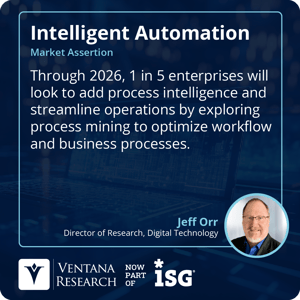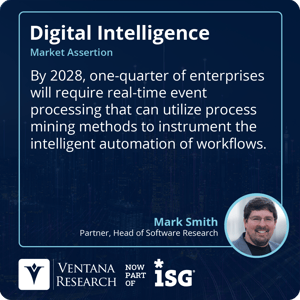Since a majority of today’s workforce wasn’t around in the 1990s, it’s worth noting that “business process reengineering” was all the rage. The purpose was to review, restructure and redesign core business processes to achieve substantial improvements in market and customer responsiveness, productivity, cycle times and quality. One reason for its popularity (beyond being a money spinner for consultants) was the promised ability for the newly available enterprise resource planning systems to be a platform for managing cross-functional business processes with much greater flexibility and efficiency than had been possible in the past. In theory, enterprise performance could be improved by guiding the step-by-step execution of the redesigned process to ensure that it is performed consistently.
However, BPR had limited success for many reasons, including an inability to systematically assess how well work was performed. Now, decades on, process mining and process intelligence hold the promise of providing enterprises with a diagnostic tool for uncovering and identifying defects in process design and execution for remediation and process improvement. It offers a practical approach to bridging the gap between theoretical process models and their actual execution in real-world settings. As with other tools, results may vary. While there’s considerable potential with process mining, it’s how the technology is used that makes a difference, the same as any other tool.
Technology is often the spur to a higher level of knowledge, and this knowledge can improve the human condition. For example, advances in grinding glass to produce high-quality lenses made the telescope and microscope possible, which spurred scientific revolutions in physics, biology and medicine. Process-mining software is another sort of lens, albeit with more modest pretensions, designed to provide greater insight and understanding of how work is performed. It’s necessary because not all business software is well implemented, and there can be considerable variation in how work is performed.
Process mining is an IT-enabled management discipline designed to monitor and analyze how enterprises perform functions. Business applications such as ERP, supply chain management, customer relationship management and other systems that manage transactions create event logs that record every action the system makes. Process mining uses these system event logs that record timestamps, user IDs and other relevant information to accurately reflect process and system states, conditions and outcomes.
Mining alone is necessary but insufficient and requires business process intelligence, which my colleague David Menninger defines as the ability to continuously measure and monitor business processes to enable rapid awareness, decision-making and response when conditions requiring action occur. Technology has only recently enabled analysis of data sets acquired through mining for insights into how end-to-end processes unfold. Process intelligence identifies poorly designed processes or execution inconsistencies that drive unwanted outcomes, such as delivery delays or unnecessary complexity in how processes are handled. Ventana Research asserts that through 2026, 1 in 5 enterprises will add process intelligence and streamline operations by exploring process mining to optimize workflow and business processes.
business processes to enable rapid awareness, decision-making and response when conditions requiring action occur. Technology has only recently enabled analysis of data sets acquired through mining for insights into how end-to-end processes unfold. Process intelligence identifies poorly designed processes or execution inconsistencies that drive unwanted outcomes, such as delivery delays or unnecessary complexity in how processes are handled. Ventana Research asserts that through 2026, 1 in 5 enterprises will add process intelligence and streamline operations by exploring process mining to optimize workflow and business processes.
Business processes can be divided into three broad categories: those that need to be performed with consistency, those that require flexibility and those that are hybrid. Modern factories are an example of the first, where production must be standardized and highly controlled to ensure quality at the lowest cost. Creative processes that seek novelty must be flexible. Process mining works best in identifying defects in business activities that require consistency in execution.
When conducting building maintenance, it’s best to start with an as-built plan rather than the designers’ blueprints because, typically, the two can diverge meaningfully. Similarly, having an as-is model of process execution provides an easier and more effective way to identify process defects and facilitate redesign. In addition to being poorly drafted, processes can be defective or suboptimal because certain types of operations must always be handled differently from the norm or if specific conditions require a different approach.
For example, in the case of the former, a typical method used by factories when issuing replacement tools requires handing in the old tool before a new one is released. However, when an airline implemented a new maintenance system, that “normal” rule resulted in substantial and expensive delays. Before, the crew could radio ahead for replacement equipment, which would be waiting nearby when the plane was parked at the gate and quickly swapped out. Having to ferry a defective piece back to the maintenance hangar and return with a new one kept the plane from making a timely departure, enraging passengers and increasing costs. As an example of special circumstances, inventory allocation to customers under normal conditions is often done on a first-come-first-served approach. Yet, supply chain delays or placement of an unusually large order often require some form of manual inventory allocation to balance the needs of existing priority customers against others. Process mining and intelligence can help identify anomalies that create process issues and help identify where redesign is necessary to ensure the desired results.
Process mining and process intelligence must be complemented by ongoing process monitoring to achieve the best outcomes. The frequency with which monitoring is performed depends on the urgency of the business need and the experienced variability of the process constrained by the capability of the tools to perform such assessment. Frequent monitoring enables an enterprise to track performance metrics, identify issues as they arise and make data-driven decisions to improve efficiency. For some use cases, the combination of real-time event processing and process mining will enable organizations to achieve agility in responding to unusual conditions. Ventana Research asserts that by 2028, one-quarter of enterprises will require real-time event processing that can perform process-mining methods to instrument intelligent automation of workflows.
depends on the urgency of the business need and the experienced variability of the process constrained by the capability of the tools to perform such assessment. Frequent monitoring enables an enterprise to track performance metrics, identify issues as they arise and make data-driven decisions to improve efficiency. For some use cases, the combination of real-time event processing and process mining will enable organizations to achieve agility in responding to unusual conditions. Ventana Research asserts that by 2028, one-quarter of enterprises will require real-time event processing that can perform process-mining methods to instrument intelligent automation of workflows.
Fundamental business challenges are eternal: Enterprises always need to provide customers with well-designed, affordable and competitively priced products and services that are marketed and sold effectively by an organization that can hire and retain the best people. But how it’s done is what counts. Technology and the tools available to enterprises are constantly changing and evolving to deal with the business environment, and those clever enough to use technology to improve performance can achieve a sustainable competitive advantage compared to rivals who lag behind. Process mining and process intelligence are technology lenses that provide executives and managers better visibility and understanding of how work is performed so they can use that knowledge to improve performance. I recommend that all enterprises have a formal program in place to enable adoption and expansion of process mining and intelligence. Such a program would bring together business and IT interests and senior executive sponsorship that sets the tone at the top to drive the change management necessary to take full advantage of new technology.
Regards,
Robert Kugel

 business processes to enable rapid awareness, decision-making and response when conditions requiring action occur. Technology has only recently enabled analysis of data sets acquired through mining for insights into how end-to-end processes unfold. Process intelligence identifies poorly designed processes or execution inconsistencies that drive unwanted outcomes, such as delivery delays or unnecessary complexity in how processes are handled. Ventana Research asserts that through 2026, 1 in 5 enterprises will add process intelligence and streamline operations by exploring process mining to optimize workflow and business processes.
business processes to enable rapid awareness, decision-making and response when conditions requiring action occur. Technology has only recently enabled analysis of data sets acquired through mining for insights into how end-to-end processes unfold. Process intelligence identifies poorly designed processes or execution inconsistencies that drive unwanted outcomes, such as delivery delays or unnecessary complexity in how processes are handled. Ventana Research asserts that through 2026, 1 in 5 enterprises will add process intelligence and streamline operations by exploring process mining to optimize workflow and business processes. depends on the urgency of the business need and the experienced variability of the process constrained by the capability of the tools to perform such assessment. Frequent monitoring enables an enterprise to track performance metrics, identify issues as they arise and make data-driven decisions to improve efficiency. For some use cases, the combination of real-time event processing and process mining will enable organizations to achieve agility in responding to unusual conditions. Ventana Research asserts that by 2028, one-quarter of enterprises will require real-time event processing that can perform process-mining methods to instrument intelligent automation of workflows.
depends on the urgency of the business need and the experienced variability of the process constrained by the capability of the tools to perform such assessment. Frequent monitoring enables an enterprise to track performance metrics, identify issues as they arise and make data-driven decisions to improve efficiency. For some use cases, the combination of real-time event processing and process mining will enable organizations to achieve agility in responding to unusual conditions. Ventana Research asserts that by 2028, one-quarter of enterprises will require real-time event processing that can perform process-mining methods to instrument intelligent automation of workflows.








